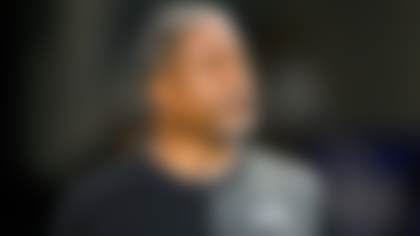*"You're never going to get it. You know what you are, Romo? You're a ball in high grass. ... Lost." -- Bill Parcells to Tony Romo, 2003. *
Tony Romo finally maneuvered the tall weeds, developing from undrafted rookie into the Dallas Cowboys' starting quarterback for the next decade. Romo's path remains the exception for modern-day quarterbacks.
In a pass-happy league, the NFL owns a startling quarterback development problem. Not only are undrafted quarterbacks, like Romo, facing enormous odds against making NFL rosters, those drafted outside the first round are almost as likely doomed to failure.
Sixteen years ago, Patriots coach Bill Belichick selected Tom Brady in the sixth round of the NFL draft. You all know that story by now: The lanky, slow, Michigan product blossomed into arguably the NFL's greatest quarterback, guiding the New England Patriots to the peak of Mount Dynasty.
Since Brady emerged, NFL coaches, scouts and fans have scoured the mid-to-late rounds of the draft for "the next Tom Brady." The searches have come up almost entirely fruitless.
Finding the "next Brady" is not only a grail quest, grooming merely starting-level signal-callers from the middle rounds has failed miserably this century.
When Philadelphia Eagles executive vice president Howie Roseman discussed his blockbuster trade with the Cleveland Browns on Wednesday to acquire the No. 2 overall pick in the 2016 NFL Draft, he noted the dearth of quality quarterbacks unearthed in the middle round.
"When you look at the history of it, there's not a large history of guys in the third, fourth, fifth rounds who end up being guys who give you the ability to compete for championships year after year," Roseman said.
The NFL treats quarterbacks similar to how shoppers consider supermarket avocados. If an avocado is too firm, not ripe enough when immediately handled, it's tossed back into the scrap heap. By the time the fruit is tender enough for the table, it's food for the landfill.
As we push toward the NFL draft next week, the suggestion of selecting a developmental quarterback to groom for the future will be cited often. In theory, this is a solid business practice. In actuality, recent history suggests there is almost no developmental process for those projects.
Current Starters
Let's begin our journey into the heart of the NFL's issue by examining the pedigree of current starting quarterbacks. To wit: the rounds in which they were selected.
Below is a breakdown of the quarterbacks currently slated to start -- or potential starters. Including unsettled jobs that gives us 34 players:
First round: 21 (includes Mark Sanchez and Blaine Gabbert)
Second round: 6 (includes Geno Smith and Colin Kaepernick)
Third round: 1
Fourth round: 1
Fifth round: 0
Sixth round: 2
Seventh round: 1 (Ryan Fitzpatrick)
Undrafted: 2 (includes Case Keenum)
Of the 34 quarterbacks, 62 percent were selected in the first round and 79 percent were drafted in the first two rounds. A minuscule five (15 percent) were taken in Rounds 3 through 7.
It hasn't been enough to merely select a first-round quarterback. The data suggest starting signal-callers should also be taken high. Of the 21 first-round picks currently in position to start, only five were selected outside the top 10: Ben Roethlisberger (11), Aaron Rodgers (24), Jay Cutler (11), Joe Flacco (18) and Teddy Bridgewater (32).
As Around The NFL's Chris Wesseling pointed out, since Flacco was selected at No. 18 overall in 2008, 20 quarterbacks have been drafted in the first round. Tim Tebow is the only one drafted outside the top five picks to win a playoff game.
Carson Palmer, taken No. 1 in 2003, is currently the NFL's oldest first-round quarterback. Thirty-seven first-round quarterbacks were selected since 2003, and 21 are in a position to start in 2016.
Draft busts such as Jamarcus Russell, Jake Locker or Johnny Manziel stand out as franchise cripplers, but the odds remain better for first-round picks than gambling on anything beyond -- even retread first-round picks have a higher success rate than their later-round counterparts.
Second- and third-round picks
We are all prisoners of the moment. As such, the recent successes of Derek Carr and Andy Dalton can skew our belief that it is just as easy to land a franchise quarterback early in the second round.
The carnage suggests it's not easy to pull off. For the Carrs, Daltons and -- to a certain extent -- Colin Kaepernicks, there are more Pat Whites, Jimmy Clausens, John Becks or Brian Brohms. Brock Osweiler was drafted 57th overall in 2012, sat for four years and earned a huge contract this offseason after just seven uneven starts, yet there remain question marks about his viability as a full-time quarterback. Geno Smith tentatively sits atop the New York Jets' depth chart, a roller coaster many Gang Green fans are terrified to ride again.
Pushing past the second round becomes even more troubling.
Russell Wilson is the only current quarterback drafted in the third round with a starting gig. A plethora of backup-caliber quarterbacks reside here, but the likes of Josh McCown, Ryan Mallett and Mike Glennon don't scream franchise player.
Let's stop for one moment to marvel at the ridiculousness of Wilson's career. Not only is the Seattle Seahawks' signal-caller an MVP-candidate, he's an outlier of Tom Brady-proportions. Forget for a second Wilson's uncanny ability as a run-pass quarterback, his penchant for conjuring big plays from certain doom or coaxing production out of receivers other evaluators disregarded. From solely a draft-position standpoint Wilson sits on a pedestal of his own.
Since at least 1980, Wilson is the only quarterback drafted in the third round or later to start every game his rookie season.
Brady famously sat a year. Romo was given two years. The great Joe Montana started just one game as a rookie. Chris Weinke and Kyle Orton each started 15 games as rookies before washing out. No quarterback in the modern era outside of Wilson has been tossed into the fire so early, flourished and continued to produce.
Some, like Glennon, show promise as rookies. But Tampa Bay quickly benched the lanky passer for journeyman Josh McCown. The Buccaneers then used the No. 1 overall pick on Jameis Winston, relegating Glennon to clipboard holder. Bucs brass rattled the rafters trying to drum up compensation for Glennon this offseason to no avail.
Others get an early shot, like Nick Foles. Then two teams realized the third-round quarterback was a product of a new Chip Kelly offense and bona fide luck who quickly regressed to the mean. Foles never improved on his weaknesses.
Many end up like the punctually challengedRyan Mallett, who still earns raves from talent scouts for his big arm. Mallett eventually was traded for minimal compensation and outplayed by two replacement-level veterans in Brian Hoyer and Ryan Fitzpatrick.
Grooming a late-round pick
Developing a late-round pick into a quality starter to take over when a franchise quarterback retires or to flip for draft picks sounds like a great business plan. It's also an almost non-existent market.
Consider the fourth- through seventh-round selections from 2009 to 2014 -- a batch of quarterbacks who should have enough development to contribute.
In those six years, 43 quarterbacks were drafted in Rounds 4-7. Of those 43 players, only 14 have started a single NFL game -- roughly one-third the number drafted -- and combined for 107 career regular-season starts.
Of those 14 players, only two are slated to start in 2016: Kirk Cousins (fourth-round pick) and Tyrod Taylor (sixth). Cousins and Taylor own 39 starts (36 percent of all starts in the draft range). Both are also openly questioned as viable long-term solutions by their teams. The Washington Redskinswant Cousins to repeat last year's success before shelling out a mega contract. The Buffalo Bills are openly taunting Taylor's agent while searching for a younger replacement.
Taking out Cousins and Taylor leaves us with 68 total starts between 12 other developmental players:
John Skelton (17), Zach Mettenberger (14), Curtis Painter (8), Ryan Lindley (6), T.J. Yates (7), AJ McCarron (3), Landry Jones (2), Joe Webb (4; now a receiver), Keith Null (4), Greg McElroy (1), Rusty Smith (1) and Stephen McGee (1).
McCarron showed promise in his three starts and one playoff loss, but the rest is a pile of rotten tomatoes.
Mettenberger has taken more selfies than thrown catchable balls and almost injured a half dozen receivers by leading them into big hits. There hasn't been a peep about a team trying to acquire Mettenberger this offseason, which speaks volumes. Jones started two games for the Pittsburgh Steelers last season and almost caused the entire fan base to have a collective coronary. Steelers fans are clamoring to draft yet another heir to Roethlisberger. Sorry to say, Jones is likely the team's best bet for a backup quarterback in 2016.
The vast majority of mid- to late-round picks are cast aside well before they get a chance to maybe/possibly/slightly develop into even a suitable backup. The Cardinals, for instance, dumped a raw Logan Thomas after just one season, replacing him with fellow fourth-round longshot Matt Barkley.
Replacing franchise quarterbacks?
Below is a sampling of some recent attempts at replacing franchise quarterbacks:
Peyton Manning (Broncos): Currently on Plan C
Peyton Manning (Colts): Andrew Luck (No. 1 overall pick)
Donovan McNabb (Eagles): Kevin Kolb/Michael Vick/Vince Young/Nick Foles/Mark Sanchez/Sam Bradford (trade)
Kurt Warner (Cardinals): Derek Anderson/John Skelton/Max Hall/Kevin Kolb/Ryan Lindley/Carson Palmer (trade)
Kurt Warner (Rams): Marc Bulger/Sam Bradford (No. 1 overall pick, four years) /Austin Davis/Shaun Hill/Nick Foles/Case Keenum/2016 No. 1 overall pick?
John Elway (Broncos): Brian Griese/Jake Plummer/Jay Cutler (No. 11 overall pick, played two full seasons)/Kyle Orton/Tim Tebow (1st round pick)/Peyton Manning (free agency)/See above
Brett Favre (Packers): Aaron Rodgers (No. 24 overall pick)
Steve Young (49ers): Jeff Garcia/Tim Rattay/Ken Dorsey/Alex Smith (No. 1 overall pick, traded in 2013)/Trent Dilfer/Shaun Hill/Chris Weinke/J.T.O'Sullivan/Troy Smith/Colin Kaepernick (second round pick, on trade block)/Blain Gabbert (trade)/?
Outside of obtaining an injured quarterback or snagging a disgruntled one, only one team -- Cowboys -- eventually developed their own non-first-round quarterback into a long-term solution.
Trades!
One common notion is that teams can select mid- to late-round quarterbacks, develop them, then flip them for much higher picks.
Let's take a gander at how some of those worked out this millennium:
Ryan Mallett: Patriots' third-round pick, 2011. In 2014, New England traded Mallett to Houston for a conditional draft pick (seventh round). Mallett started six games in two forgettable seasons with the Texans. Lacking a functional alarm clock, Mallett was cut by Houston.
Kevin Kolb: Eagles' second-round pick, 2007. In 2011, Philadelphia traded Kolb to Arizona for Dominique Rodgers-Cromartie and a second-round pick. Kolb started 14 games for the Cardinals and injuries washed out his career.
Charlie Whitehurst: Chargers' third-round pick, 2006. In 2010, San Diego traded Whitehurst to Seattle for a 2011 third-round pick, swapped 2010 second-round picks. Clipboard Jesus started just four games in two years in Seattle before becoming a nomad.
Matt Cassel: Patriots' seventh-round pick, 2005. In 2009, New England traded Cassel along with Mike Vrabel to the Kansas City Chiefs in exchange for a second-round pick. Cassel was mediocre in his four-year stint in Kansas City.
Matt Schaub: Falcons' third-round pick, 2004. In 2007, Atlanta traded Schaub to Houston for two second-round picks and the teams swapped first-round picks. Schaub earned a modicum of success with two Pro Bowls and one playoff win, but often struggled with injury and flamed out in 2013. Schaub was traded again, to the Raiders in 2014 for a sixth-round pick. Despite the Raiders' offseason posturing, he didn't start a game.
A.J. Feeley: Eagles' fifth-round pick, 2001. In 2004, Philadelphia traded Feeley to Miami in exchange for a 2005 second-round pick. Feeley started eight games for Miami before again being traded.
Matt Hasselbeck: Packers' sixth-round pick, 1998. In 2001, Green Bay traded Hasselbeck to the Seattle Seahawks for a 2001 third-round pick and the teams swapped first-round selections. Hasselbeck was great for the Seahawks, compiling three Pro Bowls, going to a Super Bowl and setting a bevy of team records.
Over the past decade and a half, these trades generated a negative slope in both compensation and outcome, which speaks to the poor development and perceived quality of tradable quarterbacks. Perhaps this is why Broncos general manager John Elway deemed Colin Kaepernickworth just a fourth-round pick.
Trading for an established starter who has been Wally Pipped has been a better solution: Alex Smith, Drew Bledsoe and Trent Green all fetched quality compensation and played well for their respective teams.
Yet, starters rarely become available without some question marks: Jay Cutler has been an enigma and cycled through five offensive coordinators since being traded to Chicago. Palmer was disgruntled and wormed his way out of two cities. Donovan McNabb was old, twice. This season Kaepernick is playing disgruntled QB card.
Even the coaching staffs perceived to be the best at developing talent have missed more than they've hit on with quarterbacks -- including Belichick.
The Patriots have selected eight quarterback since 2000, including Brady. None in the first round (list excludes Julian Edelman, who played quarterback in college):
Tom Brady, 2000, sixth round: Golden god.
Rohan Davey, 2002, fourth round: Released in 2005.
Kliff Kingsbury, 2003, sixth round: Released 2004.
Matt Cassel, 2005, seventh round: Traded in 2009 with Mike Vrabel for second-round pick (No. 34 overall; Patrick Chung)
Kevin O'Connell, 2008, third round: Waived in 2009
Zac Robinson, 2010, seventh round: Waived five months later
Ryan Mallett, 2011, third round: Traded in 2014 for a conditional 6th/7th round pick
Jimmy Garoppolo, 2014, 2nd round: Trade bait in 2017?
First off, my career goal of shoehorning Rohan Davey into an NFL.com post is complete. Oh, Rohan.
Second off, aside from the Cassel trade -- in which Belichick needed to include Vrabel -- the quarterbacks behind Brady haven't exactly returned a treasure trove. Nor have any shined brightly outside of New England. Perhaps Garoppolo will change that next year. Perhaps.
Chiefs coach Andy Reid also gets credit for developing backup quarterbacks and getting good trade compensation in return. He received second-round picks for each Kevin Kolb and A.J. Feeley during his time in Philly. Considering both quarterbacks crashed more often than the Shockwave plug-in for Google Chrome, shouldn't we consider Reid a better-used quarterback salesman than a developer of talent?
In Summation
The issue at hand is not to suggest drafting a developmental quarterback is a poor business decision, rather it is to point out that rarely have those mid-round picks actually developed.
Lack of live reps due to the shuttering of leagues like NFL Europe, constriction of practice time and evolving college offenses reliant on coaching audibles has created a startling lack of opportunity for young quarterbacks to grow into pro-ready passers.
The quarterback position has always been a crapshoot, dating to the inception of the league. However, with a greater focus on the passing game in the modern era, more importance has been placed on an already high-pressure position. With that focus comes heftier expectations on un-nurtured talent. Teams are more apt to throw an unready quarterback into the fire and if he fails to move on, rather than cultivate a passer from the ground up.
Perhaps the likes of Cousins, Taylor or McCarron will join outliers like Wilson and Brady. Even if all three made it big, developing three mid-round starting quarterbacks in a half decade could hardly be considered success.
The use of virtual reality in lieu of live bullets could conceivably help fast-track some young quarterbacks stashed behind entrenched starters who gobble up all the practice reps. However, it's likely a gap will remain among those who respond to incubation and those who thrive under the live fire of an NFL game.
Next weekend, when you hear draft analysts discuss the prospects of quarterbacks like Cardale Jones, Dak Prescott, Kevin Hogan, etc. developing into quality NFL signal-callers, know the odds are exceedingly long. It's a theory much easier stated than practiced.
Follow Kevin Patra on Twitter @kpatra.












